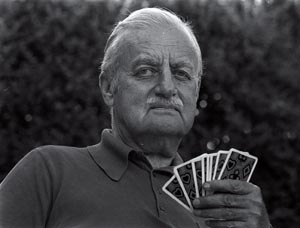Boris Schapiro
Bridge champion who secured his first world title in 1929 and his final one 66 years later, Boris Schapiro, studied Textiles at Bradford Technical College during the 1920s.
 Boris was born in Latvia in 1909. His father Herman ran a very lucrative
international horse dealing business there but when Boris was only
a small child the family moved to St Petersburg. His very comfortable
childhood of travelling to kindergarten by carriage and eating caviare
sandwiches was shattered by the Russian Revolution.
Boris was born in Latvia in 1909. His father Herman ran a very lucrative
international horse dealing business there but when Boris was only
a small child the family moved to St Petersburg. His very comfortable
childhood of travelling to kindergarten by carriage and eating caviare
sandwiches was shattered by the Russian Revolution.
The family
escaped, leaving behind everything but portable gold and diamonds as
they fled in a cattle truck to Yalta. They were only saved by meeting Captain
Sherwood, who had charge of a freighter that had carried thousands of their
horses to Hull and Goole. They sailed to Istanbul with him and travelled from
there to France, arriving in Toulon on Armistice Day, 1918.
They then moved
on to Doncaster where they still had relatives.
Once settled the Schapiros continued their international horse trading
and young Boris attended private school but played cards for money
from the age of 10. His father anticipated that the advance of motor
vehicles would create a downturn in family fortunes and so prepared for
diversification by sending his son to study textiles at Bradford Technical
College, where he graduated as a Fellow of the Textile Institute.
Boris
then went to Paris and Hamburg to study Philosophy but seems to have
been more of a playboy than serious student, chasing girls and playing
cards at the Sorbonne. He then reached the finals in the German tennis
mixed doubles during his time at Hamburg University. A talented player,
he competed at Wimbledon in 1936.
Boris spoke Russian, German and French fluently. In 1935 he acted as
an interpreter for Viscount Castlerosse, who was interviewing Hitler for
the Daily Express. Boris was arrested by the Gestapo and thrown into jail
for 2 nights after a fracas when spotted drinking in a public café with a
non Jewish companion. His language skills were later used against Hitler when he served in the Army Intelligence Corps during WWII.
When the family business was forced to change direction, not into
textiles but into meat, Boris spent the hours between visiting Smithfields
at 3am and visiting butchers shops during the day by playing bridge. At
the outbreak of war Boris ran a scrap metal business before joining up.
Boris was also an excellent rider who had won showjumping trophies
in his teens. This skill was undiminished at 48 as when the European
Championships were being held in Vienna he took the Great Britain
team to visit the famous Spanish Riding School, and rode one of the
Lippizaners through their entire routine.
But despite being multi-talented it was at bridge that Boris truly
excelled. He won his first Contract Bridge World title in 1932 and his
first major British competition in 1946, partnering Terence Reese.
He was an incorrigible joker. Having claimed that Reese was so deep
in concentration during a game that he would not notice if a naked
woman was present, Boris organised just such a visitor and won the £50
bet. Their partnership split after they were falsely accused of cheating
by using hand signals in the 1965 World Bridge Championships in
Buenos Aires.
Boris was a member of the British team that won the European Team
Championships 4 times from 1948 and Britain’s only World Open Team
title, in 1955, achieving silver in the World Teams of 1960 and the World
Pairs of 1962. He won Britain’s most prestigious event, the Gold Cup, a
record 11 times, the last time in 1998 when he was 89! The same year
he won the senior pairs at the World Bridge Championships in Lille.
Although Boris was a menacing opponent in the game he was very
popular. He taught Omar Sharif how to play bridge like a master when
the actor was on a break from filming Lawrence of Arabia and they
became great friends. He was also a legendary flirt whose opening line
when introduced to any woman was “Fancy a spot of adultery?”
Boris Schapiro died in December 2002.
Photograph courtesy of The Times